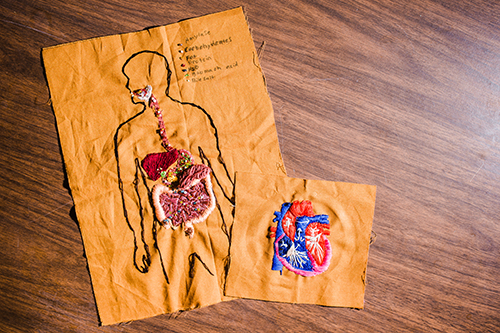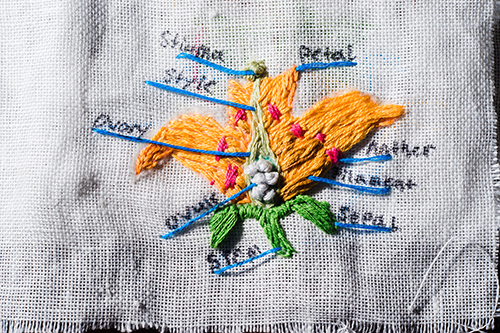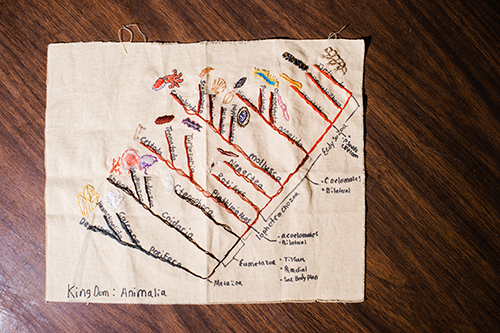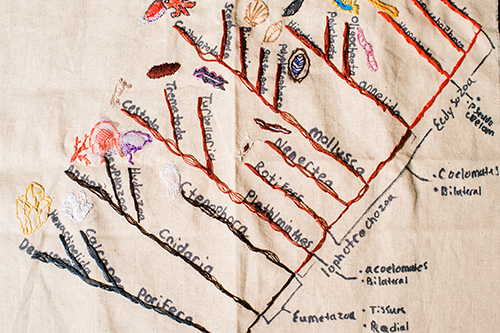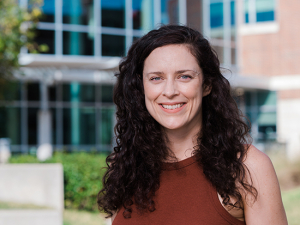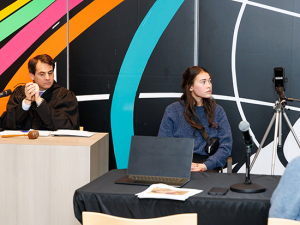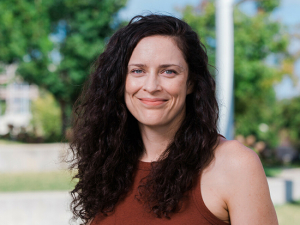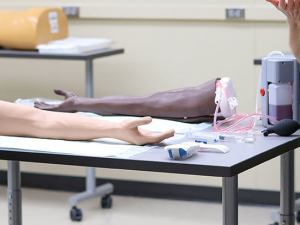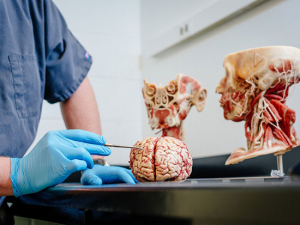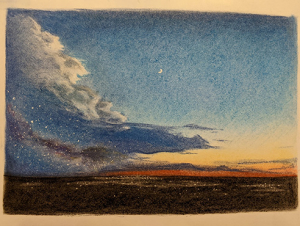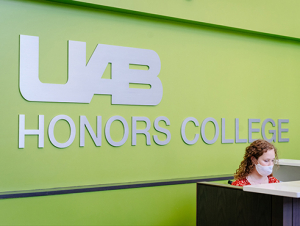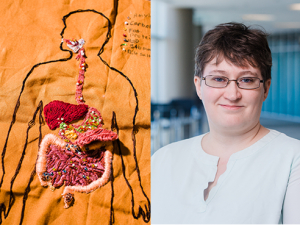Laura Calvert, a senior majoring in biomedical sciences, embroidered the human digestive system and a human heart to better absorb the course material in BY 124. LEXI COON / University Relations What ’s colorful, dynamic and a study tool all over? Laura Calvert’s embroidery work for BY 124.
Introductory Biology II covers a wide range of topics: Students learn about plant parts, cells and life cycles, the animal kingdom, how the heart works, and how the digestive system operates. Laura Calvert, a senior majoring in biomedical sciences, was not having much luck with the often-recommended method of learning — repeatedly sketching the processes and diagrams on paper — and said the idea of traditional study methods “fills me with dread, so any time I can find a way to make the process more interesting, I jump on it.”
 Laura Calvert, a senior majoring in biomedical sciences. LEXI COON / University Relations“Early in the class, I kept hearing, ‘draw, draw, draw lots of pictures and diagrams,’” she explained. “I cannot draw to save my life; but my mom had described embroidery as painting with thread, and I love the textural feel of the stitches, so for me it sort of clicked,” she continued. Though Calvert’s mother is a longtime embroiderer, Calvert is new to the art form, picking it up only a few months ago to make a holiday gift for her husband’s grandmother.
Laura Calvert, a senior majoring in biomedical sciences. LEXI COON / University Relations“Early in the class, I kept hearing, ‘draw, draw, draw lots of pictures and diagrams,’” she explained. “I cannot draw to save my life; but my mom had described embroidery as painting with thread, and I love the textural feel of the stitches, so for me it sort of clicked,” she continued. Though Calvert’s mother is a longtime embroiderer, Calvert is new to the art form, picking it up only a few months ago to make a holiday gift for her husband’s grandmother.
“I’m a highly kinetic learner with ADHD, so doing the embroideries help me focus on the materials without feeling like I’m ‘studying.’”
Embroidering also gives her several ways to interact with the material: Calvert takes about 30 minutes of research to plan the design, which takes her anywhere from one to six hours of stitching to complete.
“That’s much more time working with the material than I would get from trying to force myself to study in a nontraditional way,” she continued. Her finished designs also enable Calvert to explain the concepts to her husband or son, further engaging her with the subject matter.
Inspiring others
While Calvert completed most of her stitching in her free time, she sometimes would embroider during class — an activity that might bother some faculty, but not Calvert’s BY 124 instructor Rosianna Gray, Ph.D., assistant professor of biology. In fact, Gray says Calvert was so engaged in the course’s in-class participation activities, Gray wasn’t aware of her embroidery until late into the semester, even as Calvert consistently occupied a front-row seat.
|
“I believe metacognition is a tool that can even playing fields among students who are not at the levels of preparation or organization as other students. The world of learning is like a living organism — it changes all the time. |
“After Laura came to me and informed me of the amazing and unique way she has of learning material, I was speechless,” Gray said. “What she was doing was indeed a helpful activity in a way that I’d never seen before.”
She added that some of Calvert’s peers discovered her creative study methods, which inspired them to “think out of the box on different ways to entertain materials for the course.”
“This is one of the purest examples of helpful activities that I can imagine,” Gray explained. “This is innovative and inspirational.
“Thinking about how you think is the key,” she continued. “I believe metacognition is a tool that can even playing fields among students who are not at the levels of preparation or organization as other students. The world of learning is like a living organism — it changes all the time. The ‘fee’ for trying nontraditional methods of learning that work for you is to share that method with others, as Laura has done.”
One of Calvert's favorite projects was stitching this taxonomy tree. LEXI COON / University Relations
The intersection of art and science
|
“I’m a highly kinetic learner with ADHD, so doing the embroideries help me focus on the materials without feeling like I’m ‘studying.’” |
While the process of embroidering biological concepts might seem unusual, Calvert says the finished products are similar to 3D models or posters one might find in a research lab — just with a more artistic flair, she adds.
“Many illustrations created for science could be considered art,” Calvert explains. “The Audubon paintings of birds come to mind. They were made to be a visual reference of birds in America, but are seen as amazing works of art.”
An art-lover herself, Gray concurs, noting that both science and art require a high level of conceptual thinking. Both also stimulate curiosity, which can generate new ideas and creative approaches to the subject matter.
“Getting over the feeling of ‘wasting time’ because I was not working with the material in a standard way was — and still is — difficult but if it helps, it helps,” Calvert said. “Sometimes a different approach can make things click.”
